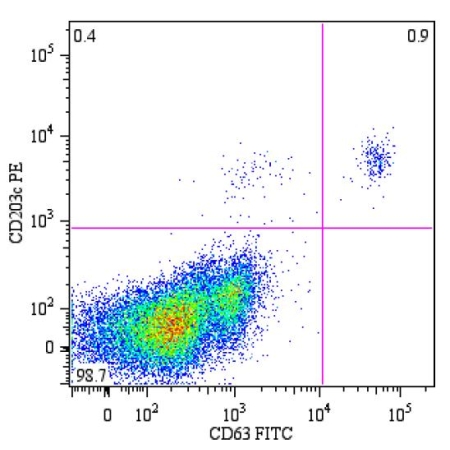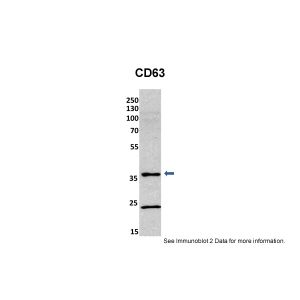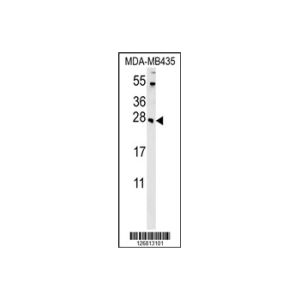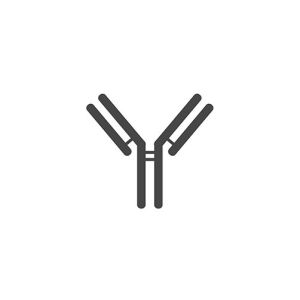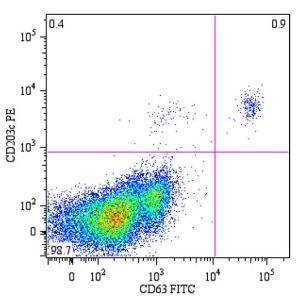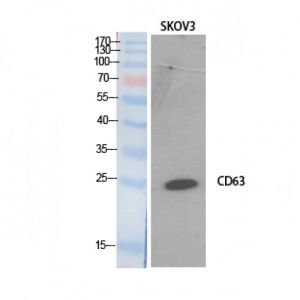CD63 Antibody
Katalog-Nummer OAEE00945
Size : 100tests(T100)
Marke : Aviva Systems Biology
| Datasheets/Manuals | Printable datasheet for CD63 Antibody |
|---|
| Predicted Species Reactivity | Human |
|---|---|
| Product Format | Stabilizing phosphate buffered saline (PBS), pH 7.4, 15 mM sodium azide |
| Clonality | Monoclonal |
| Clone | MEM-259 |
| Isotype | IgG1 |
| Host | Mouse |
| Conjugation | APC |
| Application | FC |
| Reconstitution and Storage | 2°C to 8°C |
| Immunogen | HPB-ALL T cell line |
| Purification | Purified by size-exclusion chromatography |
| Concentration | 10 ul / test |
| Specificity | The antibody MEM-259 reacts with CD63 (LAMP-3), a 40-60 kDa tetraspan glycoprotein expressed by granulocytes, platelets, T cells, monocytes/macrophages and endothelial cells. Cell surface exposition of CD63 is usually activation-dependent. |
| Formulation | APC |
| Storage Buffer | The reagent is provided in phosphate buffered saline (PBS) containing 15 mM sodium azide and 0.2% (w/v) high-grade protease free Bovine Serum Albumin (BSA) as a stabilizing agent. |
| Reference | Cerny J, Feng Y, Yu A, Miyake K, Borgonovo B, Klumperman J, Meldolesi J, McNeil PL, Kirchhausen T: The small chemical vacuolin-1 inhibits Ca(2+)-dependent lysosomal exocytosis but not cell resealing. EMBO Rep. 2004 Sep;5(9):883-8. Erratum in: EMBO Rep. 2005 Sep;6(9):898. Lin D, Kamsteeg EJ, Zhang Y, Jin Y, Sterling H, Yue P, Roos M, Duffield A, Spencer J, Caplan M, Wang WH: Expression of tetraspan protein CD63 activates protein tyrosine kinase (PTK) and enhances the PTK-induced inhibition of ROMK channels. J Biol Chem. 2008 Jan 22 Kwon MS, Shin SH, Yim SH, Lee KY, Kang HM, Kim TM, Chung YJ: CD63 as a biomarker for predicting the clinical outcomes in adenocarcinoma of lung. Lung Cancer. 2007 Jul;57(1):46-53. Israels SJ, McMillan-Ward EM: CD63 modulates spreading and tyrosine phosphorylation of platelets on immobilized fibrinogen. Thromb Haemost. 2005 Feb;93(2):311-8. Pfistershammer K, Majdic O, Stöckl J, Zlabinger G, Kirchberger S, Steinberger P, Knapp W: CD63 as an activation-linked T cell costimulatory element. J Immunol. 2004 Nov 15;173(10):6000-8. Mantegazza AR, Barrio MM, Moutel S, Bover L, Weck M, Brossart P, Teillaud JL, Mordoh J: CD63 tetraspanin slows down cell migration and translocates to theendosomal-lysosomal-MIICs route after extracellular stimuli in human immature dendritic cells. Blood. 2004 Aug 15;104(4):1183-90. Grützkau A, Smorodchenko A, Lippert U, Kirchhof L, Artuc M, Henz BM: LAMP-1 and LAMP-2, but not LAMP-3, are reliable markers for activation-induced secretion of human mast cells. Cytometry A. 2004 Sep;61(1):62-8. |
|---|---|
| Gene Symbol | CD63 |
| Gene Full Name | CD63 molecule |
| Alias Symbols | CD63 antigen, CD63 antigen (melanoma 1 antigen), granulophysin, LAMP-3, lysosomal-associated membrane protein 3, lysosome-associated membrane glycoprotein 3, ME491, melanoma-associated antigen ME491, melanoma-associated antigen MLA1, MLA1, ocular melanoma-associated antigen, OMA81H, tetraspanin-30, tspan-30, TSPAN30. |
| NCBI Gene Id | 967 |
| Protein Name | CD63 antigen |
| Description of Target | Functions as cell surface receptor for TIMP1 and plays a role in the activation of cellular signaling cascades. Plays a role in the activation of ITGB1 and integrin signaling, leading to the activation of AKT, FAK/PTK2 and MAP kinases. Promotes cell survival, reorganization of the actin cytoskeleton, cell adhesion, spreading and migration, via its role in the activation of AKT and FAK/PTK2. Plays a role in VEGFA signaling via its role in regulating the internalization of KDR/VEGFR2. Plays a role in intracellular vesicular transport processes, and is required for normal trafficking of the PMEL luminal domain that is essential for the development and maturation of melanocytes. Plays a role in the adhesion of leukocytes onto endothelial cells via its role in the regulation of SELP trafficking. May play a role in mast cell degranulation in response to Ms4a2/FceRI stimulation, but not in mast cell degranulation in response to other stimuli. |
| Uniprot ID | P08962 |
| Protein Accession # | NP_001244318.1; NP_001244319.1; NP_001244320.1; NP_001244321.1; NP_001244329.1; NP_001244330.1 |
| Nucleotide Accession # | NM_001257; NM_001257389.1; NM_001257390.1; NM_001257391.1; NM_001257392.1; NM_001257400.1 |




